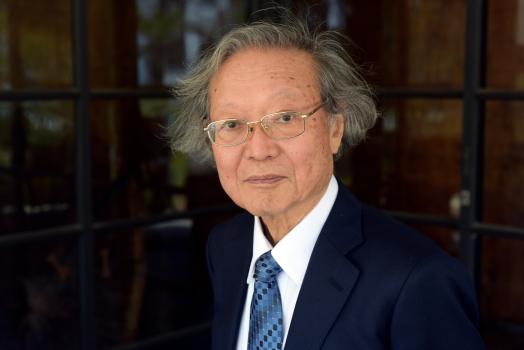
Symmetries are ubiquitous in mathematics and the physical world. Representation theory uses algebraic tools to investigate the ways in which a given symmetry can be expressed by linear transformations on vector spaces. Linear partial differential equations on the other hand are traditionally investigated using tools of analysis. Algebraic analysis, as initiated by the work of Mikio Sato (1928–2023), is a systematic study of these equations by algebraic means. Kashiwara has made groundbreaking contributions to this programme, leading to surprising connections and spectacular results in representation theory.
D-modules provide an algebraic language for studying systems of linear partial differential equations. The 1970 master’s thesis of Kashiwara develops the theory of analytic D-modules, introducing the fundamental notion of characteristic variety, and proving a vast generalization of the Cauchy–Kovalevskaya theorem. This demonstrated early on the power of algebraic methods in tackling problems of an analytic nature.
This philosophy was taken further by Kashiwara when developing the microlocal analysis of sheaves in a prolific collaboration with Pierre Schapira. In a nutshell, microlocal analysis relates differential equations on manifolds to geometric objects on the cotangent bundle. Kashiwara, together with Takahiro Kawai and Sato, introduced various fundamental new concepts in this theory and clarified the generic microlocal structure of systems of linear differential equations.
Hilbert’s 21st problem (often referred to as the Riemann–Hilbert problem) asks for the existence of a linear differential equation on the Riemann sphere with regular singularities and with prescribed local monodromies. Pierre Deligne extended and solved this problem in higher dimensions. Kashiwara formulated and proved a vastly generalized Riemann–Hilbert correspondence, i.e., the equivalence between regular holonomic D-modules and perverse sheaves. This result was obtained independently by Zoghman Mebkhout. Quite recently, Kashiwara and Andrea D’Agnolo extended the Riemann–Hilbert correspondence to holonomic D-modules that are not necessarily regular.
The Kazhdan–Lusztig conjecture in representation theory can be viewed as connecting characters of representations to intersection cohomology groups. It was proved by Kashiwara together with Jean-Luc Brylinski, in a striking application of the Riemann–Hilbert correspondence. An independent proof was obtained by Alexander Beilinson and Joseph Bernstein using different methods.
Kashiwara and Toshiyuki Tanisaki later generalized the Kazhdan–Lusztig conjecture to infinite dimensional affine Lie algebras by developing D-module theory on an infinite dimensional flag variety. Since then, D-module theory has become an indispensable tool and brought numerous new developments in representation theory, including in positive characteristic.
Inspired by the study of solvable lattice models in mathematical physics, Vladimir Drinfeld and Michio Jimbo independently formalized quantum groups in the late '80s. They are deformations of the enveloping algebras of complex semi-simple or Kac–Moody Lie algebras. Kashiwara introduced the notion of crystal graphs and proved their existence for integrable highest weight representations of quantum groups. The proof, which proceeds by an intricate induction process now known as the grand loop argument, is a tour de force that has not been much simplified over time. Kashiwara also constructed crystal bases and global bases, which were later shown to coincide with the canonical bases and their q=0 limits discovered by George Lusztig. This work can be thought of as a vast and fruitful generalization of the theory of Young diagrams and Young tableaux.
Kashiwara is an exceptionally prolific mathematician with more than seventy collaborators. For over fifty years he has reshaped and deeply enriched the fields of representation theory, in its numerous incarnations, and algebraic analysis. His work continues to be at the forefront of contemporary mathematics and to inspire generations of researchers.